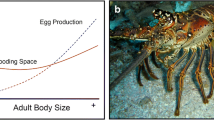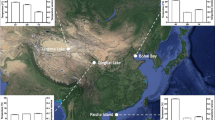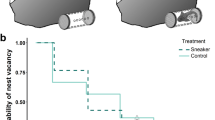Summary
The safe harbor hypothesis includes the suggestion that parental care causes the embryonic stage to be the safest harbor, and, therefore, egg size will increase in populations with parental care to decrease the duration of subsequent, higher risk stages. Neither the safe habor hypothesis nor r and K theory seem adequate to explain the correlation between egg size and the presence/absence of parental care among salamanders, a group in which there is a further correlation between the larval (hatchling) habitat and egg size/parental care. Pond-breeding salamanders generally have small eggs and lack parental care, and stream-breeding salamanders generally have large eggs and parental care. I argue that the fundamental difference in the food available to hatchling salamanders between lentic (plankton-rich) and lotic (plankton-poor) environments selects for relatively lower parental investment in the lentic environment. From the standpoint of parental fitness, small (more numerous) hatchlings have a greater payoff where the available food is mall and dense (zooplankton in lentic environments), and large hatchlings are selectively advantageous where the food is of large size and less dense (benthic invertebrates in lotic environments). Selection for larger hatchlings in lotic environments results in longer embryonic periods and,ceteris paribus, greater total embryonic mortality. Embryo hiding and guarding have evolved among lotic-breeding salamanders as compensatory mechanisms to reduce the rate of embryonic mortality. In this view, parental care is a consequence of selection for larger egg size and not an umbrella that allows egg size to increase, contrary to the safe harbor hypothesis.
The relationship between variance in parental investment and food available to offspring, developed here for salamanders, may be of general significance. YosiakiItô, a critic of r and K theory, independently arrived at a similar conclusion from a broader data base.
Similar content being viewed by others
References
Alcher, M. (1981a) Reproduction en elevage deEuproctus platycephalus (Urodela, Salamandridae).Amphibia-Reptilia 2: 97–105.
Alcher, M. (1981b) Sur l'existence de soins parentaux chezEuproctus montanus (Urodela, Salamandridae).Amphibia-Reptilia 2: 189–194.
Allen, W. E. (1920) A quantitative and statistical study of the plankton of the San Joaquin River and its tributaries in and near Stockton, California, in 1913.Univ. Calif. Publ. Zool. 22: 1–292.
Anderson, J. D. (1967) A comparison of the life histories of coastal and montane populations ofAmbystoma macrodactylum in California.Amer. Midl. Nat. 77: 323–355.
Anderson, J. D. (1968) A comparison of the food habits ofAmbystoma macrodactylum sigillatum, Ambystoma macrodactylum croceum, andAmbystoma tigrinum califoriense.Herpetologica 24: 273–284.
Anderson, J. D. andG. K. Williamson (1976) Terrestrial mode of reproduction inAmbystoma cingulatum.Herpetologica 32: 214–221.
Anderson, P. L. (1943) The normal development ofTriturus pyrrhogaster.Anat. Rec. 86: 59–63.
Antonelli, A. L., R. A. Nussbaum andS. D. Smith (1972) Comparative food habits of four species of stream-dwelling vertebrates (Dicamptodon ensatus, D. copei, Cottus tenuis, Salmo gairdneri).Northwest Sci. 46: 277–289.
Avery, R. A. (1968) Food and feeding relations of three species ofTriturus (Amphibia Urodela) during the aquatic phases.Oikos 19: 408–412.
Bell, G. (1974) The reduction of morphological variation in natural populations of smooth newt larvae.J. Anim. Ecol. 43: 115–128.
Bell, G. (1975) The diet and dentition of smooth newt larvae (Triturus vulgaris).J. Zool. (London)176: 411–424.
Bell, G. andJ. H. Lawton (1975) The ecology of the eggs and larvae of the smooth newt (Triturus vulgaris (Linn.)).J. Anim. Ecol. 44: 393–423.
Birge, E. A. andC. Juday. (1922) The inland lakes of Wisconsin. The plankton. I. Its quantity and chemical composition.Wis. Geol. Nat. Hist. Survey, Bull. Sci. ser 64 1–222.
Bishop, S. C. (1920) Notes on the habits and development of the four-toed salamander,Hemidactylium scutatum (Schlegel).New York State Mus. Bull. 219: 251–282.
Bishop, S. C. (1936) Notes on the habits and development of the mudpuppyNecturus maculosus (Rafinesque).New York State Mus. Bull. 268: 5–61.
Bishop, S. C. (1941) The salamanders of New York.New York State Mus. Bull. 324: 1–365.
Bishop, S. C. (1943)Handbook of salamanders. Comstock, Ithaca.
Branch, L. C. andR. Altig (1981) Nocturnal stratification of three species ofAmbystoma larvae.Copeia 1981: 870–873.
Brandon, R. A. andR. G. Altig (1973) Eggs and small larvae of two species ofRhyacosiredon.Herpetologica 29: 349–351.
Breder, C. M. (1935) The reproductive habits of the common catfish,Ameiurus nebulosus (LeSueur), with a discussion of their significance in ontogeny and phylogeny.Zoologica 19: 143–179.
Briegleb, W. andJ. Schwartzkopff. (1961) Verhaltensweisen des Grottenolms (Proteus anguinus Laur.) und das Problem des Fortplanzungsraumes.Naturwissenschaften 22: 1–3.
Brockelman, W. Y. (1975) Competition, the fitness of offspring, and optimal clutch size.Amer. Natur. 109: 677–699.
Brodie, E. D., Jr., J. L. Hensel, Jr. andJ. A. Johnson (1974) Toxicity of the urodele amphibiansTaricha, Notophthalmus, Cynops, andParamesotriton (Salamandridae).Copeia 1974: 506–511.
Brown, H. A. (1976) The time-temperature relation of embryonic development in the northwestern salamander,Ambystoma gracile.Can. J. Zool. 54: 552–558.
Bruce, R. C. (1968) Life history studies of the salamanders of the genusPseudotriton (Caudata: Plethodontidae). Ph.D. Dissertation, Duke University.
Cadwallader, P. L. (1976) Breeding biology of a non-diadromous galaxiid,Galaxias vulgaris Stokell, in a New Zealand river.J. Fish. Biol. 8: 157–177.
Connon, F. E. (1947) A comparative study of the respiration of normal and hybridTriturus embryos and larvae.J. Exp. Zool. 105: 1–24.
Curtis, B. (1938)The life story of the fish. D. Appleton-Century Co., New York.
Despax, R. (1923) Contribution a l'etude anatomique et biologique des batraciens urodeles, du groupe des euproctes et specialement de l'euprocte des PyreneesTriton (Euproctus) asper Duges Theses pour Docteur Sci. Nat. Toulouse, Ser. A, No.929.
Dodson, S. I. (1970) Complementary feeding niches sustained by size-selective predation.Limnol. and Oceanog. 15: 131–137.
Duellman, W. E. andJ. T. Wood (1954) Size and growth of the two-lines salamander,Eurycea bislineata rivicola.Copeia 1954: 92–96.
Dunn, E. R. (1923) The breeding habits of salamanders and their bearing on phylogeny.Copeia 115: 25–28.
Dunn, E. R. (1926)Salamanders of the family Plethodontidae. Smith College, Fiftieth Anniversary Publ. ser. Vol.7.
Ferrier, V. (1974) Chronologie du developpement de l'amphibien urodeleTylotriton verrucosus Anderson (Salamandridae).Ann. d'Embryol. et de Morphogenese 7: 407–416.
Gallien, L. andO. Bidaud (1959) Table chronologique de developpement chezTriturus helveticus Raz.Bull. Soc. Zool. Fr. 84: 22–32.
Gallien, L. andM. Durocher (1957) Table chronologique de developpement chezPleurodeles waltlii Michah.Bull. Biol. Fr. Belg. 91: 97–114.
Gasser, F. (1964) Observations sur les stades initiaux du developpment de l'urodele PyreneenEuproctus asper.Bull. Soc. Zool. Fr. 89: 423–428.
Gould, S. J. (1977)Ontogeny and phylogeny. Belknap Press, Harvard UniversityCambridge.
Green, N. B., P. Brant, Jr., andB. Dowler (1967)Eurycea lucifuga in West Virginia: its distribution, ecology, and life history.Proc. W. Virginia Acad. Sci. 39: 297–304.
Hamilton, W. J., Jr. (1940) The feeding habits of larval newts with reference to availability and selection of food items.Ecology 21: 351–356.
Hardin, G. (1956) Meaninglessness of the word protoplasm.Sci. Monthly 82: 112–120.
Hardy, J. D., Jr. (1969) A summary of recent studies on the salamander,Ambystoma mabeei.Chesapeake Biol. Lab. Ref. No.69-20: 1–3.
Hirschfield, M. F. andD. W. Tinkle (1975) Natural selection and the evolution of reproductive effort.Proc. Nat. Acad. Sci. 72: 2227–2231.
Hutchinson, V. H. (1956) Notes on the plethodontid salamanders,Eurycea lucifuga (Rafinesque), andEurycea longicauda longicauda (Green).Occas. Paps. Natl. Speleol. Soc. 3: 1–24.
Itô, Y. (1959)Comparative ecology. Iwanami, Tokyo (in Japanese).
Itô, Y. (1970) Groups and family bonds in animals in relation to their habitat. 389–415. InL. R. Aronson, E. Tobach, D. S. Lehrman andJ. S. Rosenblatt (eds)Development and evolution of behavior. W. H. Freeman and Co., San Francisco.
Itô, Y. (1980)Comparative ecology. Second ed., trans. byJ. Kikkawa. Cambridge University Press, Cambridge.
Itô, Y. andY. Iwasa (1981) Evolution of litter size I. Conceptual reexamination.Res. Popul. Ecol. 23: 344–359.
Iwasawa, H. andY. Kera (1980) Normal stages of development of the Japanese lungless salamander,Onychodactylus japonicus (Houttuyn).Jap. J. Herpetol. 8: 73–89 (in Japanese).
Kaplan, R. H. (1980) The implications of ovum size variability for offspring fitness and clutch size within several populations of salamanders (Ambystoma).Evolution 34: 51–64.
Kerbert, C. (1904) Zur Fortpflanzung vonMegalobatrachus maximus Schlegel (Cryptobranchus japonicus v.d. Hoeven).Zool. Anz. 27: 305–320.
Knight, F. C. E. (1938) Die Entwicklung vonTriton alpestris bei verschiedenen Temperaturen mit Normentafel.Wilhelm Roux's Archives 137: 461–473.
Kuramoto, M. (1978) Correlations of quantitative parameters of fecundity in amphibians.Evolution 32: 287–296.
Lack, D. (1954) The evolution of reproductive rates. 143–156. InJ. Huxley, A. C. Hardy andE. B. Ford (eds)Evolution, as a process. Allen and Unwin, London.
Licht, L. E. (1975a) Comparative life history features of the western spotted frog,Rana pretiosa, from low-and high-elevation populations.Can. J. Zool. 53: 1254–1257.
Licht, L. E. (1975b) Growth and food of larvalAmbystoma gracile from a lowland population in southwestern British Columbia.Can. J. Zool. 53: 1716–1722.
MacArthur, R. H. (1962) Some generalized theorems of natural, selection.Proc. Natl. Acad. Sci. 48: 1893–1897.
MacArthur, R. H. andE. O. Wilson (1967) The theory of island biogeography. Princeton University Press, Monographs in Pop. Biol.1.
Martof, B. S. (1962) Some aspects of the life history and ecology of the salamanderLeurognathus.Amer. Midl. Natur.,67: 1–35.
Noble, G. K. (1927) The value of life history data in the study of the evolution, of the Amphibia.Ann. New York Acad. Sci. 30: 31–128.
Noble, G. K. andM. K. Brady (1933) Observations of the life history of the marbled salamander,Ambystoma opacum Gravenhorst.Zoologica 11: 89–132.
Nussbaum, R. A. (1969a) Nests and eggs, of the Pacific giant salamander,Dicamptodon ensatus (Eschscholtz).Herpetologica 25: 257–262.
Nussbaum, R. A. (1969b) A nest site of the Olympic salamander,Rhyacotriton olympicus (Gaige).Herpetologica 25: 277–278.
Nussbaum, R. A. (1985) The evolution of parental care in salamanders.Misc. Publ. Museum of Zoology, University of Michigan 169: 1–50.
Nussbaum, R. A. andC. K. Tait (1977) Aspects of the life history and ecology of the Olympic salamander,Rhyacotriton olympicus (Gaige).Amer. Midl. Natur. 98: 176–199.
Nussbaum, R. A., E. D. Brodie, Jr. andR. M. Storm (1983) Amphibians and reptiles of the Pacific Northwest. University of Idaho Press, Moscow.
Orr, L. P. andW. T. Maple (1978) Competition avoidance mechanisms in salamander larvae of the genusDesmognathus.Copeia 1978: 679–7685.
Parry, G. D. (1981) The meanings of r-and K-selection.Oecologia 48: 260–264.
Pearre, J. Jr. (1980) Feeding by Chaetognatha: the relation of prey size to predator size in several species.Mar. Ecol. Prog. Ser. 3: 125–134.
Pennak, R. W. (1943) Limnological variables in a Colorado mountain stream.Amer. Midl. Natur. 29: 186–199.
Petranka, J. W. andJ. G. Petranka (1980) Selected aspects of the larval ecology of the marbled salamanderAmbystoma opacum in the southern portion of its range.Amer. Midl. Natur. 104: 352–363.
Petranka, J. W., J. J. Just andE. C. Crawford (1982) Hatching of amphibian embryos: the physiological trigger.Science 217: 257–259.
Pianka, E. R. (1970) On r-and K-selection.Amer. Natur. 104: 592–597.
Pianka, E. R. (1978)Evolutionary ecology. Harper New York.
Pope, C. H. (1924) Notes on North Carolina salamanders with especial reference to the egg-laying habits ofLeurognathus andDesmognathus.Amer. Mus. Novit. 153: 1–15.
Regal, P. J. (1966) Feeding specializations and the classification of terrestrial salamanders.Evolution 20: 392–407.
Riemer, W. J. (1958) Variation and systematic relationships within the salamander genusTaricha..Univ. Calif. Publ. Zool. 56: 301–390.
Salthe, S. N. (1969) Reproductive modes and the number and sizes of ova in the urodeles.Amer. Midl. Nat. 81: 467–490.
Salthe, S. N. andW. E. Duellman (1973) Quantitative constraints associated with reproductive mode in anurans. 229–249. InJ. L. Vial, (ed)Evolutionary biology of the anurans. Univ. Missouri Press, Columbia.
Shine, R. (1978) Propagule size and parental care: the “safe harbor” hypothesis.J. Theor. Biol. 75: 417–424.
Smith, B. G. (1907) The life history and habits ofCryptobranchus allegheniensis.Biol. Bull. 13: 5–39
Smith, B. G. (1912) The embryology ofCryptobranchus allegheniensis, including comparisons with some other vertebrates.J. Morphol. 23: 61–157.
Smith, C. S. andS. D. Fretwell (1974) The optimal balance between size and number of offspring.Amer. Natur. 108: 499–506.
Stearns, S. C. (1977) The evolution of life history traits: a critique of the theory and a review of the data.Ann. Rev. Ecol. Syst. 8: 145–171.
Strathmann, R. R. (1977) Egg size, larval development, and juvenile size in benthic marine invertebrates.Amer. Natur. 111: 373–376.
Svärdson, G. (1949) Natural selection and egg number in fish.Institute of Freshwater Research, Fishery Board of Sweden. Rept. No.29: 115–122.
Tago, K. (1929) Notes on the habits and life history ofMegalobatrachus japonicus.X e Congress Internatl. Zool. Budapest1: 828–838.
Thorn, R. (1968) Les salamanders d'Europe, d'Asie, et d'Afrique du nord. Paul Lechevalier, Paris.
Thorson, G. (1946) Reproduction and larval development of Danish marine bottom invertebrates, with special reference to the planktonic larvae in the sound (Oresund).Medd. Komm. Danm. Fisk.—og Havunders., Ser. Plankton 4: 1–523.
Tilley, S. G. (1968) Size-fecudity relationships and their evolutionary implications in five desmognathine salamanders.Evolution 22: 806–816.
Tilley, S. G. (1970) Aspects of the reproductive ecology ofDesmognathus ochrophaeus in the southern Appalachian Mountains. Ph.D. Thesis, Univ. Mich, Ann Arbor.
Twitty, V. C. (1936) Correlated genetic and embryological experiments onTriturus. I and II.J. Exp. Zool. 74: 239–302.
Twitty V. C. (1966)Of scientists and salamanders. W. H. Freeman, San Francisco.
Utsunomiya, Y. andT. Utsunomiya (1977) On the development ofTylototriton andersoni.J. Fac. Fish. Anim. Husb., Hiroshima Univ. 16: 65–76 (in Japanese).
Vance, R. R. (1973a) On reproductive strategies in marine benthic invertebrates.Amer. Natur. 107: 339–352.
Vance R. R. (1973b) More on reproductive strategies in marine benthic invertebrates.Amer. Natur. 107: 353–361.
Vandel, A. andM. Bouillon (1959) La reproduction du Protee (Proteus anguinus Laurenti).C. R. Acad. Sci. Paris 248: 1267–1272.
Wake, D. B. (1966) Comparative osteology and evolution of the lungless salamanders, family Plethodontidae.Mem. So. Calif. Acad. Sci. 4: 1–111.
Welch P. S. (1935)Limnology McGraw-Hill Book Co., Inc., New York.
Werner, E. A. (1974) The fish size, prey size, handling time relation in several sunfishes and some implications.J. Fish. Res. Bd. Can. 31: 1531–1536.
Wilbur, H. M., D. W. Tinkle andJ. P. Collins (1974) Environmental certainty, trophic level, and resource availability in life history evolution.Amer. Natur 108: 805–817.
Williams, G. C. (1966)Adaptation and natural selection: a critique of some current evolutionary thought Princeton University Press, Princeton, N.J.
Author information
Authors and Affiliations
Rights and permissions
About this article
Cite this article
Nussbaum, R.A. Parental care and EGG size in salamanders: An examination of the safe harbor hypothesis. Res Popul Ecol 29, 27–44 (1987). https://doi.org/10.1007/BF02515423
Issue Date:
DOI: https://doi.org/10.1007/BF02515423




